If a Dental Implant Was Palced Wrong Can It Be Removed and Inserted Again
Dental implants provide a potent foundation for fixed or removable prosthesis that are made to replace natural teeth. However, the restoration of teeth with implant supported crowns or bridges, is a technique-sensitive process and can be a challenge for the surgical-restorative team [i].
Several factors such as the quantity and quality of available alveolar residue ridge that, the right positioning of the implant, the soft tissue biotype, the selection of the implant abutment, the provisional restoration and the fabrication of the definitive crown touch clinical outcomes [2].
The successful placement of dental implants in the edentulous upper or lower jaw can be compromised past the lack of adequate alveolar bone volume and the amount of available bone is one of the critical factors determining the ultimate success of the implant [3].
Implant angulation is yet another determinant for implant success. Proper angulation should exist determined according to the future prosthesis with the consideration of bucco-lingual, apico-coronal, and mesio-distal positions.
Coronal positioning of the implant is required to mask the metal view of the implant while, placing the implant-abutment surface more apically also leads to clinical difficulties regarding the establishment of the biologic width around the implant [4].
Besides, the implant should exist angulated correctly in the bucco-lingual and mesio-distal planes for optimum part and esthetics. Endosseous implants distribute occlusal loads most finer when forces are practical in an centric direction. As implant angulation approaches or exceeds 25 degrees, the supporting bone is severely compromised through manual of occlusal forces. Moreover, if an implant is inclined and the prosthetic reconstruction is offset relative to the implant caput, the inclination volition results in poor esthetic outcomes every bit well as long-term biomechanical instability [five].
To maximize the outcome of implant placement, the use of advanced radiographic procedures such as computerized tomography, forth with fabrication of surgical guides, has been advocated to inform surgeons of ideal implant location. More than recently, simulation calculator software has been introduced to view radiographic images and test potential implant locations and still, surgical guides are processed based on ideal tooth position [6].
However, recent technology have allowed more anticipated placement of dental implants, the malposition of endosseous implants is still non uncommon. Therefore, several techniques have been described to surgically or prosthodontically compensate for improperly inclined implants [7-10].
Additionally, the removal of endosseous implants may be performed in cases of severe implant malposition and in patients with serious complaints despite that the explantation procedure can be complicated in some situations [11].
The nowadays clinical instance written report describes an culling technique for the surgical management of an unfavorable implant position by relocating the aforementioned implant during the postoperative period.
Patient intake and diagnosis
A 39-twelvemonth-old Caucasian non-smoking female was referred to a specialist for implant handling. The patient was in good general wellness and did not accept any subjective dental complaints except of a malpositioned dental implant. The dental history revealed that, half-dozen months agone, her general dentist extracted the get-go left lower molar (molar no nineteen) planning to replace it with a dental implant. Subsequently completion of a five months postoperative period, the dentist indented to place an implant with diameter 4.eight mm and length of 12mm (Straumann ®, Standard Plus Implant Arrangement, Institute Straumann AG, Basel, Switzerland). During surgery, he noticed that the alveolar socket of the extracted molar (molar no nineteen) was not fully healed despite the prolonged postoperative menstruum (Effigy 1) and in agreement with the patient, decided to insert the implant in the position of the distal root (distal attribute of the socket) and close to 2nd tooth (Figure ii). After suture removal, he reconsidered the treatment plan based also on his dental technician stance and patient will, every bit a successful prosthetic rehabilitation couldn't be ensured (Figure three).
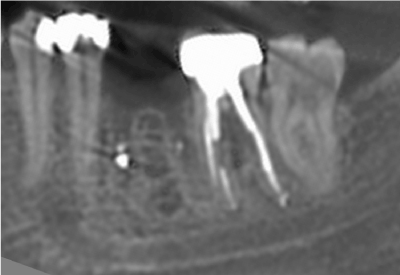
Figure 1: After completion of a five months postextraction menstruum, the alveolar socket of the extracted tooth (no 19) was non fully healed.
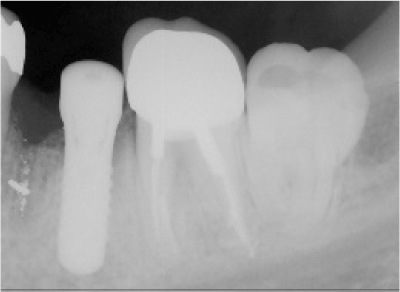
Figure ii: An implant was placed in the position of the distal root of the extracted first lower molar and close to second tooth.
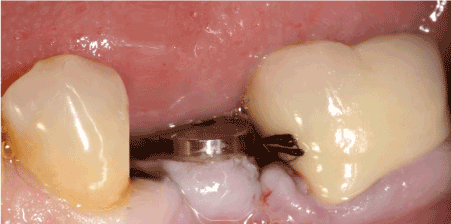
Figure 3: Due to implant malposition a successful prosthetic rehabilitation couldn't be ensured.
Therefore, he referred the patient for implant removal and re implantation.
Treatment planning
During the oral examination and evaluation of the periodontal condition, the oral hygiene appeared to be acceptable and no farther clinical findings were nowadays. Based on the dental history, the clinical and radiographic examinations, the treatment plan included atraumatic removal of the implant and immediate relocation of the same implant in a prosthetically suitable position. The surgical process was scheduled in a period of iv to six weeks later start insertion considering this timepoint combined an adequate soft tissue healing afterward initial implant placing and avoidance of osseointegration that could compromise atraumatic removal.
Surgical procedure
Preoperatively, the alveolar bone book was assessed based on previous CT scan radiographic exam (Effigy 4). Adequate bone height of 15 mm away from alveolar nerve and width of ix mm was estimated. The relocation of the same implant (4.viii x 12 mm) in the middle of the edentulous area was attainable. The patient received antibiotic prophylaxis prior to surgery.
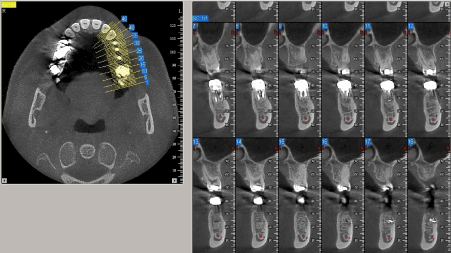
Effigy four: Preoperatively, the alveolar os volume was assessed based on previous CT scan radiographic examination.
After careful superlative of the mucosal layer, the alveolar ridge between lower left 2nd premolar and molar was exposed and the implant was removed without any damage of the alveolar bone or the material (Effigy v). Implant removal was achieved by applying the manufacturer implant transfer part and the ratchet and turning information technology initially clockwise (like catastrophe insertion procedure) with a high torque more than 50 N/cm upward to disconnect the immature bone implant contact and afterwards counterclockwise for implant retrieval. The removed implant was submerged in a dish with claret and saline and used again after socket debridement (Effigy vi). Thereafter, the alveolar socket (mesial aspect) was exposed and cleaned with os curettes every bit complete wound closure had not been achieved. The removal of debris from the socket was completed by irrigation with saline. The empty space of the mesial socket defect and the implant crenel afterwards explantation was filled with 0.5 cc xenograft granules of 0.25 to 1 mm in bore (BioOss®, Geistlich Pharma AG, Wolhusen, Switzerland) to facilitate the proper guidance of drilling and implant insertion. Therefore, implant placement was performed in a proper position co-ordinate to manufacturer guidelines with the exception of low speed drilling (200-400 rpm) with minimal water cooling to avert graft particle loss (Figure seven). The implant remained submerged with flap closure. Sutures were applied and postoperative instructions were given. Antibiotic coverage of 500 mg amoxicilline times per day was applied. Postsurgical pain and edema were controlled with 600 mg ibuprofen three times per day, and the patient was instructed to rinse twice daily with 0.12% chlorhexidine for two weeks and to use modified oral hygiene procedures in the treated area for the first vi postoperative weeks.
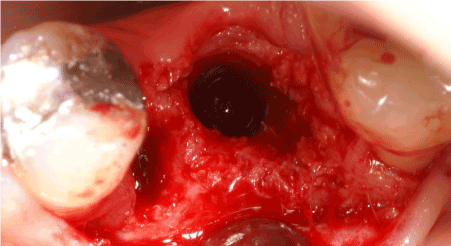
Figure five: Afterward careful elevation of the mucosal layer, the alveolar ridge betwixt lower left 2nd premolar and molar was exposed and the implant was removed.
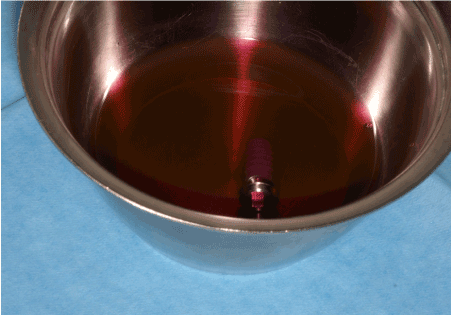
Figure half dozen: The removed implant was submerged in a dish with blood and saline and used again later on socket debridement.
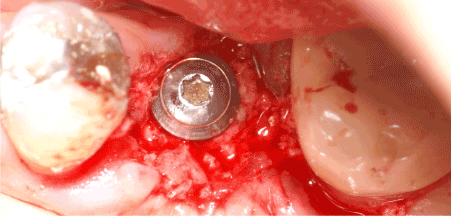
Effigy vii: Implant placement was performed according to manufacturer surgical guidelines in a proper position.
Follow-up intendance
The patient was examined two weeks later and the sutures were removed. Radiographic examination was too performed (Figure 8). The patient was maintained in a supportive intendance programme and control appointments in one case per month were scheduled. V months after insertion, the implant was exposed and an abutment was connected. A single metal ceramic crown was fabricated iv weeks later (Figure ix). Ane year after prosthetic rehabilitation, a reevaluation of the instance was performed. The general periodontal status was stable and the patient had accomplished a very good level of plaque command. No dental complaints were reported. Clinical examination of the implant placed in the augmented area revealed no mobility and healthy peri-implant mucosa. The radiographic examination confirmed bone-implant contact without any sign of radiolucency around the implant (Figure x). Further the patient has completed 3 years of functional loading, following annual check-upward with no additional clinical findings.
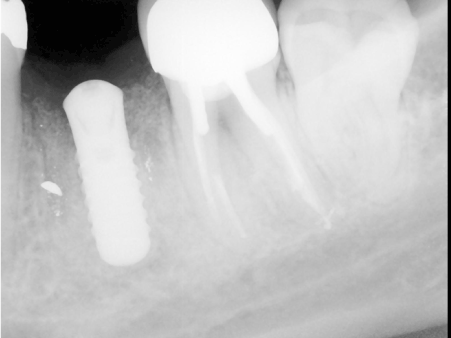
Figure eight: Radiographic examination was performed two weeks after implant relocation in a suitable position.
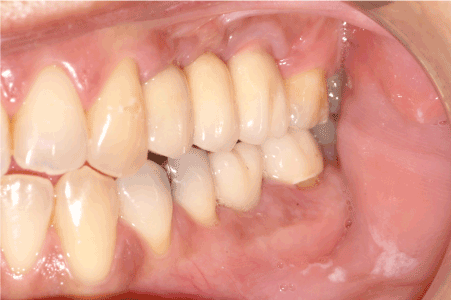
Effigy ix: Clinical view of the prosthesis that was fabricated vi months after implant placement.
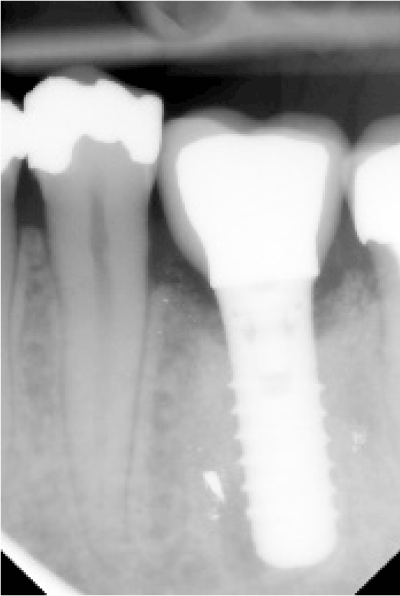
Figure 10: The radiographic test confirmed bone-implant contact without whatever sign of radiolucency around the implant.
An of import determinant for implant success is implant angulation and position and despite contempo technology have immune more predictable placement of dental implants, the malposition of endosseous implants is still a nightmare for surgeons and prosthodontists. Therefore, numerous techniques take been described for malpositioned endosseous implants to surgically or prosthodontically correct the improper inclination.
From the prosthetic aspect, unacceptably inclined implants tin lead to more than technically demanding prosthodontic management to compensate for the potential esthetic complexity. Measures like long time provilization to allow the establishment of soft-tissue profile and optimize gingival esthetics, placing of implant shoulder deep enough beneath the cemento-enamel junction of the side by side teeth to contribute to a more favorable emergence profile or using custom abutment as it tin exist easily shaped to the desired definitive profile may heighten the overall esthetic result [12,xiii].
Regarding the surgical point of view, to forbid excessive angulation, the surgeon should evaluate the position of the osteotomy after use of the pilot drill by placing a parallel pin in the pilot hole and taking a radiograph. If the angulation is non satisfactory, a drill can be used to adjust the angulation before standing preparation of the implant site. Yet, in instance of unacceptably inclined implants, few reports proposed repositioning of the prosthetically unfavorable implant by piezoelectric osteotomy or vertical distraction osteogenesis [7,x].
Additionally, removal of endosseous implants may be performed in cases of severe implant malposition. However, os and soft tissue defects may be following explantation and guided bone regeneration in conjunction with soft tissue grafting are used to endeavor correction of the defect although a difficulty in accomplishing complete correction of the deficiencies has been described [fourteen].
Based on these limitations, numerous companies advise extraction kits that allow dentists to retreat cases by extracting osseointegrated implants with an atraumatic manner using a set of particular trephines to avert loftier forces and amend the final results, achieving the best outcomes for patients [15].
Despite the survival rate of dental implants that were placed in sites where failed implants were previously removed is very loftier [sixteen], previous implant removal may discourage practitioners to perform implant placement in the same position or in the same session.
However, there is lack of evidence regarding the atraumatic explantation of malpositioned implant that could be placed the aforementioned itself once again in a suitable position.
Finally, in guild to avoid the retrieval of a malpositioned dental implant, the importance of thorough communication among all members of the dental implant squad should be emphasized.
Correct positioning of the implant in a 3-dimensional management is an of import key gene that contributes to the success of the restoration and tooth replacement. This clinical example report describes an alternative technique for the surgical direction of an unfavorable implant position by relocating the aforementioned implant during the postoperative flow. The malpositioned implant was removed without whatsoever damage of the alveolar bone or the fabric and placed again in a suitable position. No adverse reactions were observed. Thereafter, the patient has completed iii years of functional loading, following annual check-up with no complains or clinical issues.
The authors accept no fiscal interest in any of the companies mentioned in this article and received no bounty for writing this commodity.
- Sadan A, Blatz MB, Salinas TJ, Block MS (2004) Single-implant restorations: a gimmicky approach for achieving a predictable outcome. J Oral Maxillofac Surg 62: 73-81. [Crossref]
- Buser D, Martin Westward, Belser UC (2004) Optimizing esthetics for implant restorations in the anterior maxilla: Anatomic and surgical considerations. Int J Oral Maxillofac Implants 19: 43-61. [Crossref]
- Belser UC, Buser D, Hess D, Schmid B, Bernard JP, Lang NP (1998) Aesthetic implant restorations in partially edentulous patients – A critical appraisal. Periodontol 2000 17: 132-150. [Crossref]
- Hermann JS, Buser D, Schenk RK, Higginbottom FL, Cochran DL (2000) Biologic width around titanium implants. A physiologically formed and stable dimension over time. Clin Oral Implants Res eleven: one-11. [Crossref]
- Misch Grand, Wang HL (2008) Implant surgery complications: etiology and handling. Implant Dent 17: 159-168. [Crossref]
- Jabero M, Sarment DP (2006) Avant-garde surgical guidance technology: a review. Implant Dent xv: 135-142. [Crossref]
- Stacchi C, Costantinides F, Biasotto M, Di Lenarda R (2008) Relocation of a malpositioned maxillary implant with piezoelectric osteotomies: a case report. Int J Periodontics Restorative Dent 28: 489-495. [Crossref]
- Lewis South, Avera S, Engleman M, Beumer J 3rd (1989) The restoration of improperly inclined osseointegrated implants. Int J Oral Maxillofac Implants 4: 147-152. [Crossref]
- Duff RE, Razzoog ME (2006) Management of a partially edentulous patient with malpositioned implants, using all-ceramic abutments and all-ceramic restorations: A clinical report. J Prosthet Dent 96: 309-312.
- Oduncuoglu BF, Alaaddinoglu EE, Oguz Y, et al. (2011) Repositioning a prosthetically unfavorable implant past vertical distraction osteogenesis. J Oral Maxillofac Surg 69: 1628-1632.
- x Bruggenkate CM, Sutter F, van den Berg JP, Oosterbeek HS (1994) Explanation procedure with special accent on the ITI implant system. Int J Oral Maxillofac Implants 9: 223-229. [Crossref]
- Jemt T (1999) Restoring the gingival contour by ways of conditional resin crowns afterward single-implant treatment. Int J Periodontics Restorative Dent 19: 20-29. [Crossref]
- Tan PL, Dunne JT Jr (2004) An esthetic comparison of a metal ceramic crown and cast metal abutment with an all-ceramic crown and zirconia abutment: a clinical report. J Prosthet Dent 91: 215-218. [Crossref]
- Horvath SD, Kohal RJ (2011) Rehabilitation of an extensive anterior explanation defect--a case study. Quintessence Int 42: 539-545.
- Anitua E, Orive Chiliad (2012) A new arroyo for atraumatic implant explantation and immediate implant installation. Oral Surg Oral Med Oral Pathol Oral Radiol 113: e19-25. [Crossref]
- Mardinger O, Ben Zvi Y, Chaushu Thousand, Nissan J, Manor Y (2012) A retrospective analysis of replacing dental implants in previously failed sites. Oral Surg Oral Med Oral Pathol Oral Radiol 114: 290-293. [Crossref]
Editorial Information
Editor-in-Master
Shigeru Watanabe
Meikai University
Article Type
Case Written report Article
Publication history
Received date: Nov 21, 2017
Accepted date: December 05, 2017
Published date: December 08, 2017
Copyright
© 2017 Nikolidakis D. This is an open-access article distributed nether the terms of the Creative Commons Attribution License, which permits unrestricted use, distribution, and reproduction in whatsoever medium, provided the original author and source are credited.
Citation
Nikolidakis D, Sykaras Due north (2017) Removal of a malpositioned implant and firsthand re-implantation during healing period. Dent Oral Craniofac Res 4: DOI: ten.15761/DOCR.1000248

Figure 1: After completion of a five months postextraction catamenia, the alveolar socket of the extracted tooth (no nineteen) was non fully healed.

Figure ii: An implant was placed in the position of the distal root of the extracted first lower molar and shut to second molar.

Figure three: Due to implant malposition a successful prosthetic rehabilitation couldn't exist ensured.

Figure four: Preoperatively, the alveolar bone volume was assessed based on previous CT scan radiographic examination.

Effigy 5: After conscientious elevation of the mucosal layer, the alveolar ridge between lower left 2nd premolar and tooth was exposed and the implant was removed.

Figure six: The removed implant was submerged in a dish with blood and saline and used again after socket debridement.

Figure 7: Implant placement was performed according to manufacturer surgical guidelines in a proper position.

Figure 8: Radiographic examination was performed two weeks after implant relocation in a suitable position.

Figure nine: Clinical view of the prosthesis that was fabricated six months afterward implant placement.

Figure 10: The radiographic exam confirmed os-implant contact without any sign of radiolucency around the implant.
Source: https://www.oatext.com/removal-of-a-malpositioned-implant-and-immediate-re-implantation-during-healing-period.php
0 Response to "If a Dental Implant Was Palced Wrong Can It Be Removed and Inserted Again"
Post a Comment